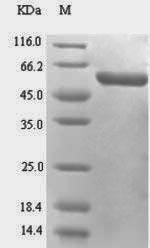Recombinant Rat Mucosal addressin cell adhesion molecule 1 (Madcam1) is expressed in E.coli and comprises the extracellular domain from amino acids 20 to 353. The protein appears to carry an N-terminal 6xHis-SUMO tag for enhanced stability and purification. SDS-PAGE analysis suggests the product achieves a purity exceeding 90%, which may ensure high-quality research applications. This protein is designed for research use only and has not been tested for clinical applications.
Mucosal addressin cell adhesion molecule 1 (Madcam1) plays what seems to be a crucial role in mediating leukocyte trafficking to mucosal tissues. The molecule is primarily involved in immune system processes, where it appears to help bind lymphocytes to endothelial cells lining blood vessels. MAdCAM-1 emerges as a key player in cellular adhesion processes and shows particular significance in studies examining immune response and inflammation.
Potential Applications
Note: The applications listed below are based on what we know about this protein's biological functions, published research, and experience from experts in the field. However, we haven't fully tested all of these applications ourselves yet. We'd recommend running some preliminary tests first to make sure they work for your specific research goals.
Based on the provided information, the recombinant rat MAdCAM-1 extracellular domain is expressed in E. coli. This prokaryotic system is fundamentally unsuitable for producing a properly folded and functional eukaryotic cell adhesion molecule. Although only the extracellular domain (20-353aa) is expressed, it retains multiple immunoglobulin-like domains that are critically dependent on the formation of complex, specific disulfide bonds for their correct tertiary structure and stability. E. coli's ability to facilitate proper disulfide bonding for such a multi-domain protein is inefficient and often results in misfolded species. Furthermore, MAdCAM-1 is heavily glycosylated in vivo, a modification that E. coli cannot perform, which can affect the protein's stability and authentic biological interactions. The presence of a large N-terminal 6xHis-SUMO tag may further impair correct folding. The >90% purity indicates low contamination but does not confirm native conformation. Since activity is unverified, the protein can not considered properly folded and biologically active without experimental validation of its structure (e.g., analysis of disulfide bonds, secondary structure) and function (e.g., binding to its receptor, α4β7 integrin).
1. Protein-Protein Interaction Studies Using Pull-Down Assays
The N-terminal 6xHis-SUMO tag enables technical immobilization for pull-down assays. However, if MAdCAM-1 is misfolded (likely due to incorrect disulfide bonds), its receptor-binding sites will not be presented correctly. Any interactions identified with α4β7 integrin or other partners are highly likely to be non-physiological artifacts. This application is not recommended without prior confirmation of native folding and binding activity.
2. Antibody Development and Validation
This application is appropriate. The recombinant protein can serve as an immunogen for generating antibodies that recognize linear epitopes of the MAdCAM-1 sequence, even if the protein is misfolded. The high purity is sufficient for immunization. However, it is crucial to note that resulting antibodies may not recognize conformational, disulfide-dependent, or glycosylation-dependent epitopes present on the native MAdCAM-1 protein in tissues. Validation against glycosylated, native MAdCAM-1 is essential.
3. Biochemical Characterization and Biophysical Analysis
This application is well-suited and should be a priority. Techniques like circular dichroism (to assess secondary structure), analytical size-exclusion chromatography (to check oligomeric state and folding quality), and mass spectrometry (to analyze disulfide bonding) can directly evaluate the conformational state of the recombinant product. These studies are valuable for characterizing the recombinant MAdCAM-1 protein itself, regardless of its bioactivity.
4. Cell Adhesion Assay Development
This application is high-risk and unreliable without functional validation. A misfolded, unglycosylated MAdCAM-1 extracellular domain will not support specific, physiological lymphocyte adhesion via α4β7 integrin. Using this protein to coat surfaces for adhesion assays will likely yield false-negative or misleading results. This application should be avoided unless proper folding and integrin-binding functionality are conclusively demonstrated.
Final Recommendation & Action Plan
Given the high probability of misfolding due to the E. coli expression system's inability to reliably form the complex disulfide bonds required for MAdCAM-1, the following plan is recommended: First, prioritize rigorous biophysical and biochemical characterization using non-reducing SDS-PAGE and mass spectrometry to probe disulfide bond status, circular dichroism for secondary structure, and size-exclusion chromatography for aggregation state. Antibody development can proceed in parallel. Crucially, avoid all functional and interaction studies (Applications 1 and 4) until the protein's structure is validated. If functional studies are required, the protein must be tested in a solid-phase binding assay with a known binding partner (e.g., recombinant α4β7 integrin) to confirm activity. For reliable results in cell adhesion or interaction studies, sourcing MAdCAM-1 from a mammalian expression system capable of proper glycosylation and folding is strongly advised.






